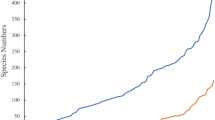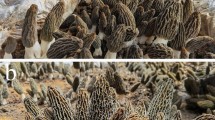Abstract
The caterpillar fungus Ophiocordyceps sinensis (best known as Cordyceps sinensis) mummifies ghost moth larvae exclusively in Tibetan Plateau alpine ecosystems. Touted as “Himalayan Viagra”, the fungus is highly prized due to its medical benefits and dwindling supplies. Attempts to culture the sexual fruiting-body have failed and the huge market demand has led to severe devastation of local ecosystems and to the fungus heading towards extinction. By genome sequencing, we establish that unlike related insect pathogens O. sinensis contains two compatible mating-type genes in its genome and is self-fertile, i.e. homothallic. However, sexual processes are only initiated under native environmental conditions. O. sinensis resembles biotrophic plant pathogens in having a genome shaped by retrotransposon-driven expansions. The resulting changes in gene content suggest that O. sinensis has a biphasic pathogenic mechanism beginning with stealth pathogenesis in early host instars. O. sinensis is the first psychrophilic fungus sequenced and is adapted to extreme cold with putative antifreeze proteins and mechanisms for increasing lipid accumulation and fatty acid unsaturation. We hypothesize that for the inbreeding O. sinensis the massive proliferation of retrotransposons provides a tradeoff between the advantages of increased genetic variation independent of sexual recombination and deletion of genes dispensable for its specialized pathogenic lifestyle.
Article PDF
Similar content being viewed by others
Avoid common mistakes on your manuscript.
References
Zhang Y J, Li E W, Wang C S, et al. Ophiocordyceps sinensis, the flagship fungus of China: Terminology, life strategy and ecology. Mycology, 2012, 3: 2–10
Winkler D. Yartsa Gunbu (Cordyceps sinensis) and the fungal commodification of the rural economy in Tibet AR. Eco Bot, 2008, 62: 291–306
Dong C H, Yao Y J. Nutritional requirements of mycelial growth of Cordyceps sinensis in submerged culture. J Appl Microbiol, 2005, 99: 483–492
Paterson R R. Cordyceps: A traditional Chinese medicine and another fungal therapeutic biofactory? Phytochemistry, 2008, 69: 1469–1495
Mycology S R. Last stand for the body snatcher of the Himalayas? Science, 2008, 322: 1182
Holliday J, Cleaver M. Medicinal value of the caterpillar fungi species of the genus Cordyceps (Fr.) Link (Ascomycetes). A review. Int J Med Mushrooms, 2008, 10: 219–234
Stone R. Bhutan. Improbable partners aim to bring biotechnology to a Himalayan kingdom. Science, 2010, 327: 940–941
Cannon P F, Nigel L, Hywel-Jones, et al. Steps towards sustainable harvest of Ophiocordyceps sinensis in Bhutan. Biodivers Conserv, 2009, 18: 2263–2281
Li J F, Zou Z W, Liu X, et al. Biology of Thitarodes pui (Lepidoptera, Hepialidae) a host species of Ophiocordyceps sinensis. J Environ Entomol, 2011, 33: 195–202
Zheng P, Xia Y L, Zhang S W, et al. Genetics of Cordyceps and related fungi. Appl Microbiol Biotechnol, 2013, 97: 2797–2804
Ni M, Feretzaki M, Sun S, et al. Sex in fungi. Annu Rev Genet, 2011, 45: 405–430
Zhang S, Zhang Y J, Liu X Z, et al. Cloning and analysis of the MAT1-2-1 gene from the traditional Chinese medicinal fungus Ophiocordyceps sinensis. Fungal Biol, 2011, 115: 708–714
Duan Z B, Chen Y X, Huang W, et al. Linkage of autophagy to fungal development, lipid storage and virulence in Metarhizium robertsii. Autophagy, 2013, 9: 538–549
Li R, Zhu H, Ruan J, et al. De novo assembly of human genomes with massively parallel short read sequencing. Genome Res, 2010, 20: 265–272
Parra G, Bradnam K, Korf I. CEGMA: A pipeline to accurately annotate core genes in eukaryotic genomes. Bioinformatics, 2007, 23: 1061–1067
Zhang Z, Cariero N, Zheng D, et al. PseudoPipe: An automated pseudogene identification pipeline. Bioinformatics, 2006, 22: 1437–1439
Zheng P, Xia Y L, Xiong C H, et al. Genome sequence of the insect pathogenic fungus Cordyceps militaris, a valued Traditional Chinese Medicine. Genome Biol, 2011, 12: R116
Xiao G H, Ying S H, Zheng P, et al. Genomic perspectives on the evolution of fungal entomopathogenicity in Beauveria bassiana. Sci Rep, 2012, 2: 483
Gao Q, Jin K, Ying S H, et al. Genome sequencing and comparative transcriptomics of the model entomopathogenic fungi Metarhizium anisopliae and M. acridum. PLoS Genet, 2011, 7: e1001264
Dyer P S, O’Gorman C M. Sexual development and cryptic sexuality in fungi: Insights from Aspergillus species. FEMS Microbiol Rev, 2012, 36: 165–192
Medema M H, Blin K, Cimermancic P, et al. AntiSMASH: Rapid identification, annotation and analysis of secondary metabolite biosynthesis gene clusters in bacterial and fungal genome sequences. Nucleic Acids Res, 2011, 39: W339–W346
Fedorova N D, Moktali V, Medema M H. Bioinformatics approaches and software for detection of secondary metabolic gene clusters. Methods Mol Biol, 2012, 944: 23–45
Venketesh S, Dayananda C. Properties, potentials, and prospects of antifreeze proteins. Crit Rev Biotechnol, 2008, 28: 57–82
Fang W G, St. Leger R J. RNA binding proteins mediate the ability of a fungus to adapt to the cold. Environ Microbiol, 2010, 12: 810–820
Zhang Y J, Xu L L, Zhang S, et al. Genetic diversity of Ophiocordyceps sinensis, a medicinal fungus endemic to the Tibetan Plateau: Implications for its evolution and conservation. BMC Evol Biol, 9: 290
Floudas D, Binder M, Riley R, et al. The Paleozoic origin of enzymatic lignin decomposition reconstructed from 31 fungal genomes. Science, 2012, 336: 1715–1719
Tamura K, Peterson D, Peterson N, et al. MEGA5: Molecular evolutionary genetics analysis using maximum likelihood, evolutionary distance, and maximum parsimony methods. Mol Biol Evol, 2011, 28: 2731–2739
Spanu P D, Abbott J C, Amselem J, et al. Genome expansion and gene loss in powdery mildew fungi reveal tradeoffs in extreme parasitism. Science, 2010, 330: 1543–1546
Duplessis S, Cuomo C A, Lin Y C, et al. Obligate biotrophy features unraveled by the genomic analysis of rust fungi. Proc Natl Acad Sci USA, 2011, 108: 9166–9171
Martin F, Kohlrt A, Murat C, et al. Périgord black truffle genome uncovers evolutionary origins and mechanisms of symbiosis. Nature, 2010, 464: 1033–1038
Spanu P D. The genomics of obligate (and nonobligate) biotrophs. Annu Rev Phytopathol, 2012, 50: 91–109
Ma L J, van de Does H C, Borkovivh K A, et al. Comparative genomics reveals mobile pathogenicity chromosomes in Fusarium. Nature, 2010, 464: 363–373
Galagan J E, Calvo S E, Cuomo C, et al. Sequencing of Aspergillus nidulans and comparative analysis with A. fumigatus and A. oryzae. Nature, 2005, 438: 1105–1115
Nygren K, Strandberg R, Wallberg A, et al. A comprehensive phylogeny of Neurospora reveals a link between reproductive mode and molecular evolution in fungi. Mol Phylogenet Evol, 2011, 59: 649–663
Glass N L, Dementhon K. Non-self recognition and programmed cell death in filamentous fungi. Curr Opin Microbiol, 2006, 9: 553–558
Wang C S, St. Leger R J. A collagenous protective coat enables Metarhizium anisopliae to evade insect immune responses. Proc Natl Acad Sci USA, 2006, 103: 6647–6652
St. Leger R J, Wang C S. Genetic engineering of fungal biocontrol agents to achieve greater efficacy against insect pests. Appl Microbiol Biotechnol, 2010, 85: 901–907
St Leger R J, Joshi L, Bidochka M J, et al. Construction of an improved mycoinsecticide overexpressing a toxic protease. Proc Natl Acad Sci USA, 1996, 93: 6349–6354
Rappleye C A, Goldman W E. Fungal stealth technology. Trends Immunol, 2008, 29: 18–24
Wang B, Kang Q J, Lu Y Z, et al. Unveiling the biosynthetic puzzle of destruxins in Metarhizium species. Proc Natl Acad Sci USA, 2012, 109: 1287–1292
Amaretti A, Raimondi S, Sala M, et al. Single cell oils of the cold-adapted oleaginous yeast Rhodotorula glacialis DBVPG 4785. Microb Cell Fact, 2010, 9: 73
D’Amico S, Collins T, Marx J C, et al. Psychrophilic microorganisms: Challenges for life. EMBO Rep, 2006, 7: 385–389
Hofrichter M, Ullrich R, Pecyna M J, et al. New and classic families of secreted fungal heme peroxidases. Appl Microbiol Biotechnol, 2010, 87: 871–897
Raffaele S, Kamoun S. Genome evolution in filamentous plant pathogens: Why bigger can be better. Nat Rev Microbiol, 2012, 10: 417–430
Author information
Authors and Affiliations
Corresponding author
Additional information
These authors contributed equally to this work.
This article is published with open access at Springerlink.com
Electronic supplementary material
Rights and permissions
This article is published under an open access license. Please check the 'Copyright Information' section either on this page or in the PDF for details of this license and what re-use is permitted. If your intended use exceeds what is permitted by the license or if you are unable to locate the licence and re-use information, please contact the Rights and Permissions team.
About this article
Cite this article
Hu, X., Zhang, Y., Xiao, G. et al. Genome survey uncovers the secrets of sex and lifestyle in caterpillar fungus. Chin. Sci. Bull. 58, 2846–2854 (2013). https://doi.org/10.1007/s11434-013-5929-5
Received:
Accepted:
Published:
Issue Date:
DOI: https://doi.org/10.1007/s11434-013-5929-5




